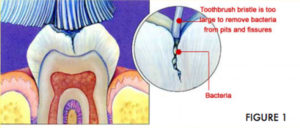Preventive Resin Restoration

We practice preventive dentistry, but also focus on caring for acute and chronic dental needs. We do our best to achieve early detection, early intervention, & prevention, and we hope to instill the same philosophy in our patients. As part of a complete preventive program, we advocate brushing and flossing, use of fluoride, good nutrition, restoring fractured fillings and teeth, treating decay as soon as possible, and regular dental examinations. Additionally, for maximum benefit, PREVENTIVE RESIN RESTORATIONS, or “PRRs”, can be used as part of the total preventive dental care regimen.
Preventive Resin Restorations, like sealants, are fillings that are applied to the deep grooves on the biting surfaces of teeth. These deep grooves of the molar and bicuspid teeth harbor bacteria and are the most vulnerable to decay. Though sealants are still a viable treatment, the material is not as durable, and the technique not as fastidious as the PRR technique. There is minimal prepping to the tooth and the material used is more wear resistant to chewing forces. This provides significantly longer protection for the tooth and prevents decay in its early stages of development.
Specifically, the procedure entails cleaning the grooves thoroughly, both mechanically and chemically, and filling the groove with flowable composite material. The filling material coats the pits and grooves, creating a shallow and smooth surface so that food and bacteria simply slide off the tooth surface.
As shown in Figure 1 above, toothbrush bristles cannot effectively clean out bacteria in these deep pits and narrow grooves and the trapped bacteria now have the opportunity to spread and cause decay. Additionally, there is usually minimal enamel undermining these pits. The thinner enamel layer provides a more direct portal to the underlying dentin, which is even more susceptible to decay.
Appropriate use of Preventive Resin Restorations can save time, money and the discomfort associated with some dental procedures. These restorations allow us to manage the decay early in its development which not only maintains sound tooth structure but minimizes/eliminates the need for the anesthetic. Waiting until the tooth becomes systematic will most likely result in deeper and more problematic decay.




